You should try a one minute quiz before you start reading
#1. If an object is placed at a distance of 0.5 m in front of a plane mirror then the distance between the object and the image formed is
#2. We can see a non-luminous object when light:
#3. Which of the following is/are not always necessary to observe a shadow?
#4. An erect and enlarged image can be formed by
#5. Which of the following can be used to form a real image?
Results
Your Introductory knowledge is adequate you can continue to read the summary.

Your Introductory knowledge is inadequate you may need to revise a little before you read the summary.

What makes things visible?
Reflected light which is received by our eyes, enables us to see things.
Some common phenomena associated with light such as image formation by mirrors, the twinkling of stars, colors of a rainbow, bending of light by a medium etc.
Laws of reflection of light.
- Angle of incidence is equal to the Angle of reflection.
- Incident ray, the reflected ray and the normal to the mirror at the point of incidence all lie in the same plane.
Formation of image by a plane mirror.
- It is always virtual and erect.
- It is laterally inverted.
- The size of the image is equal to that of the object.
- It is formed is as far behind the mirror as the object is in front of it.
Some common terms
- The reflecting surface of a spherical mirror forms a part of a sphere.
- The center of the reflecting surface of a spherical mirror is a point called the pole. It lies on the surface of the mirror and is represented by the letter P.
- The center of this sphere is called the center of curvature of the spherical mirror. It is represented by the letter C. The center of curvature is not a part of the mirror.
- The center of curvature of a concave mirror lies in front of it and lies behind the mirror for a convex mirror.
- The radius of the sphere is called the radius of curvature of the mirror. It is represented by the letter R. Note that distance PC is equal to the radius of curvature.
- An imaginary line passing through the pole and the center of curvature of a spherical mirror is called the principal axis. The principal axis is normal to the mirror at its pole.
- Rays parallel to the principal axis falling on a concave mirror all meet/intersect at a point on the principal axis of the mirror which is called the principal focus of a concave mirror. Rays parallel to the principal axis, reflected by a convex mirror appear to come from a point on the principal axis called the principal focus of a convex mirror. The principal focus is represented by the letter F.
- The distance between the pole and the principal focus of a spherical mirror is called the focal length represented by the letter f.
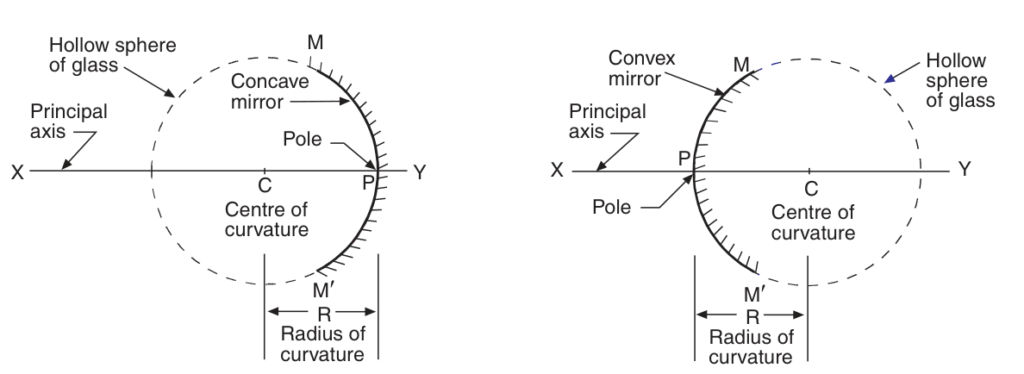
10.2.1 Some special rays
A ray of light which is parallel to the principal axis of a concave mirror, passes through its focus after reflection from the mirror.
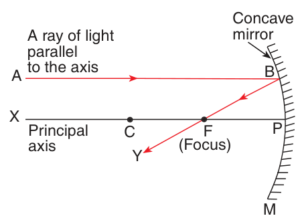
A ray of light passing through the center of curvature of a concave mirror is reflected back along the same path
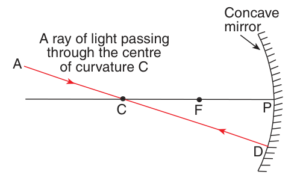
A ray of light passing through the focus of a concave mirror becomes parallel to the principal axis after reflection.
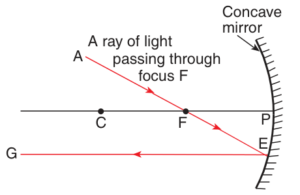
A ray of light which is incident at the pole of a concave mirror is reflected back making the same angle with the principal axis.
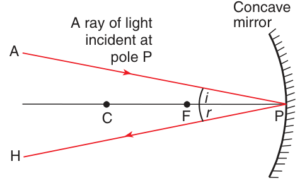
10.2.2 Representation of Images Formed by Spherical Mirrors Using Ray Diagrams

When an object is placed between the pole (P) and focus (F) of a concave mirror, the image formed is :
(i) behind the mirror,
(ii) virtual and erect, and
(iii) larger than the object (or magnified).

When an object is placed at the focus of a concave mirror, the image formed is :
(i) at infinity,
(ii) real and inverted, and
(iii) highly magnified (or highly enlarged).

When an object is placed between the focus (F) and center of curvature (C) of a concave mirror, the image formed is :
(i) beyond the center of curvature,
(ii) real and inverted, and
(iii) larger than the object (or magnified).

When an object is placed at the center of curvature (C) of a concave mirror, the image formed is :
(i) at the center of curvature (C),
(ii) real and inverted, and
(iii) same size as the object.

When an object is placed beyond the center of curvature (C) of a concave mirror, the image formed is :
(i) between the focus and center of curvature,
(ii) real and inverted, and
(iii) smaller than the object (or diminished).

When an object is at infinity from a concave mirror, the image formed is :
(i) at the focus (F),
(ii) real and inverted, and
(iii) much smaller than the object (or highly diminished).
10.2.3 New Cartesian Sign Conventions for Reflection by Spherical Mirrors
Assumptions:
Pole (P) of the mirror is taken as the origin
The principal axis of the mirror is taken as the X-axis (X’X) of the coordinate system.

Conventions:–
(i) The object is always placed to the left of the mirror. This implies that the light from the object falls on the mirror from the left-hand side.
(ii) All distances parallel to the principal axis are measured from the pole of the mirror.
(iii) All the distances measured to the right of the origin (along + x-axis) are taken as positive while those measured to the left of the origin (along – x-axis) are taken as negative.
(iv) Distances measured perpendicular to and above the principal axis (along + y-axis) are taken as positive.Distances measured perpendicular to and below the principal axis (along –y-axis) are taken as negative.
10.2.4 (a) Mirror Formula
The distance of the object from its pole is called the object distance (u).
The distance of the image from the pole of the mirror is called the image distance (v). The distance of the principal focus from the pole is called the focal length (f).
The relationship between these three quantities given by the mirror formula

This formula is valid in all situations for all spherical mirrors for all positions of the object. You must use the New Cartesian Sign Convention while substituting numerical values for u, v, f, and R in the mirror formula.
(b) Magnification
Magnification produced by a spherical mirror gives the relative extent to which the image of an object is magnified with respect to the object size. It is expressed as the ratio of the height of the image (h2) to the height of the object (h1). It is usually represented by the letter m.

Magnification (M) is also related to the object distance (u) and image distance (v).

A negative sign of the magnification indicates that the image is real.
A positive sign of the magnification indicates that the image is virtual.
Fantastic!! Now that you have reached the end off this post you could continue to the next part of this topic or take a break 🙂






